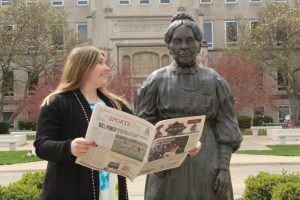Two years ago, the Bradley and Peoria communities were recovering from a horrific alcohol-related tragedy.
Sheridan “Danny” Dahlquist was killed in August 2007 after his roommates set off roman candles underneath his bedroom door.
What we didn’t know at the time was that tragedy would strike again – soon, when junior Robert Hurt was killed after being accidentally pushed into traffic by a friend while they were walking along University Street.
If you weren’t at Bradley at this time, ask an upperclassman about it who was. The attitude here was one of shock and grief as newspaper headline after newspaper headline reminded everyone that two students had been killed in alcohol-related accidents.
So the administration reacted. University President Joanne Glasser formed a committee to address the alcohol culture on campus.
What we now know as the Comprehensive Alcohol Action Plan is what came of that committee.
Now, the question is what next?
The plan has been implemented for three semesters, and it’s hard to tell what’s working and what’s not.
School officials told the Scout this week they’re pleased with the fact that the average blood alcohol content is at .079, the lowest it’s been in at least five years.
At the same time, though, the 13 students were taken to the emergency room last semester for alcohol-related reasons. Only four were taken in all of the 2008-09.
Admittedly, it’s hard to tell what the cause of that is. Maybe the number from 2008-09 was a fluke, which makes the 13 from this fall look outlandish.
But it still means four, and then 13, students were taken to the hospital.
Administrators seem to think the fact that more students were treated in emergency rooms lies with their fellow students, who administrators believe are more aware of the signs of alcohol poisoning, which leads them to call 911 more often.
We’re not so quick to agree with that assessment, but it probably played a small role.
Not only did the number of students taken to the hospital transported jump more than three times, but 171 students were cited for underage drinking last semester.
That number by itself may not seem too big a deal, but the fact that a total of 174 tickets were written during the entire 2008-09 school year puts the 171 in perspective.
Granted, about half of those tickets were issued at one large party, but the fact remains that if the trend continues, twice as many tickets will be issued this school year than last.
So, back to our question: what now?
What should the university do with these numbers? It’s hard to say.
On one hand, the alcohol plan’s only been in place for three semesters, and as the administration touted publicly at a July press conference, looking at last year’s data it would seem like the plan is working.
Looking at this fall’s numbers, it doesn’t seem to be working quite as well.
So on the other hand, maybe it’s time to revisit the situation.
Administrators never expected to eliminate underage drinking, but they did expect to start curbing it – and that’s not happening.
We don’t expect Bradley to embrace underage drinking– but maybe the stiff fines aren’t working.
Maybe more education, before alcohol becomes a problem, is key. We’d be willing to wager that many of those 13 students taken to the emergency room were freshmen living away from home for the first time. So maybe education before they actually arrive on campus is the solution – we don’t know, but it seems to make sense.
The alcohol plan can’t be a static document that governs a rather large part of college life. It has to be one that’s ever-changing, otherwise, odds are it’s going to continue to lose its effectiveness.
The university had to create the alcohol plan – it would have been irresponsible not to respond to the events from 2007-08.
But the university also needs to assess what percent of students will choose to let the plan affect them, rather than continue on with their usual ways and act invincible to consequence. It would be foolish to think all 18 to 22 year-olds accept governance from their elders.
That percent of students is what needs to be analyzed, with resources invested accordingly.



